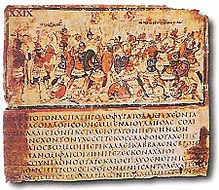User:Rhiannon38/sandbox
Ambrosian Iliad (Class: Early Medeival Art)[edit]

The Ambrosian Iliad (also known as Ilias Picta, or Milan Iliad) is a late antique illuminated manuscript produced on vellum[1], and was originally part of a manuscript depicting the entirety of Homer's Iliad, including battle scenes and tranquil scenes. The Ambrosian Iliad is considered unique due to being the only set of ancient illustrations that depict scenes from the Iliad, and it is seen as an example of the transition from Greek oral tradition to the written word[2]. The Ambrosian Iliad consists of 52 miniatures that are estimated to have been cut from their original manuscript before the 13th Century, each labeled numerically. Comparisons of texts per page to other late antique manuscripts (Vatican Vergil, Vienna Genesis)[1] has led some to speculate these miniatures were originally part of a large manuscript[3]. Interestingly, this manuscript is unlike other illuminated manuscripts in it's lack of gilding. Instead, the author(s) chose yellow ochre to represent gold within the individual images, i.e. the gold cuirasses of noble figures, and the halo of Zeus (folios XXXIV)[4].

The origin of the Ambrosian Iliad is widely debated, some believing that it was manufactured in Alexandria given the flattened and angular Hellenistic figures, which is considered typical of Alexandrian art in the Late Antiquity period[5]. Others believe it was produced in Constantinople, specifically 493 AD to 508 AD, where the inscriptions identifying the subjects was added[6]. Ranuccio Bianchi Bandinelli, who studied the collection of folios, stated that the Ambrosian Iliad would have been a costly book to make, strictly for wealthy patrons, however thelack of metals used within the manuscript is believed to prove otherwise[7].
Based on paleographic study of the manuscript's Greek uncial script, the creation of the Ambrosian Iliad is dated between the 1st and 5th Centuries (AD), and possibly worked on by several artists[8]. Each image was labelled by Cardinal Angelo Mai in his attempt to keep count in his study of the various pages in 1813, and in 1819 he recreated the images as engravings[9]. Cardinal Mai did some additional damage in applying harsh chemicals to the script in order to read it, causing the figures to bleed through the pages[3]. Over time the paint has deteriorated, revealing that the author(s) first drew the figures nude and then painted the clothes on, much like in Greek vase painting[10].
Today the Ambrosian Iliad is held in the Biblioteca Ambrosiana in Milan, which is also the manuscript's namesake. It was purchased from Genoese collector Gian Vincenzo Pinelli’s library and added, by Cardinal Frederico Borromeo, to the Biblioteca Ambrosiana library June 14th, 1608[11]. The manuscript's images can be viewed on the Warburg Institute Iconographic Database.
- ^ a b Kleiner, Fred (2012). Gardner's Art Through the Ages. Cengage Learning. pp. 85, 86, 248–250. ISBN 978-0495915423.
- ^ Daskalopoulos, Anastasios (1999). "Homer, The Manuscripts, and Comparative Oral Traditions". ProQuest.
- ^ a b Bare, Ceil (2009). "Achilles and the Roman Aristocrat: The Ambrosian Iliad as a Social Statement". Florida State University.
- ^ Desmarais, Norman (May 2003). "Acta Sanctorum2003227Acta Sanctorum. Ann Arbor, MI: ProQuest Information and Learning 2002. Contact publisher for pricing URL: http://acta.chadwyck.com Last visited February 2003". Reference Reviews. 17 (5): 11–12. doi:10.1108/09504120310480805. ISSN 0950-4125.
{{cite journal}}: External link in|title= - ^ Coarelli, Filippo (1962). "The Painted Cups of Begram and the Ambrosian Iliad". East and West. 13 (4): 317–335. JSTOR 29754619.
- ^ Randall, Lilian M. C. (1956). "Review of Hellenistic-Byzantine Miniatures of the Iliad (Ilias Ambrosiana)". American Journal of Archaeology. 60 (4): 464–466. doi:10.2307/500894. JSTOR 500894.
- ^ Alexander, Shirley (1968). "Problems of Metal Usage In Some Late Antique and Early Christian Manuscripts". ProQuest.
- ^ Weitzmann, Kurt (1979). Age of Spirituality: Late Antique and Early Christian Art, Third to Seventh Century. New York: Thhe Metropolitan Museum of Art. pp. 216, 217. ISBN 0870991795.
- ^ Louchheim, Aline (1953). "As Greeks Saw It: ILIAS AMBROSIANA". New York Times.
- ^ Bury, Jane (1897). "Early Christian Miniatures". ProQuest.
- ^ "10 Collections for the Bibliophile". Museum Network. 2018-05-11. Retrieved 2018-12-04.
